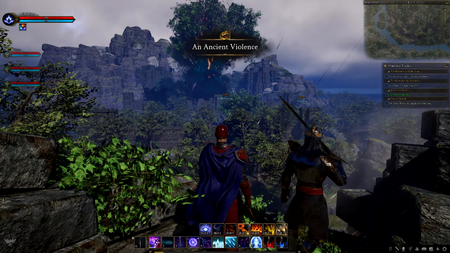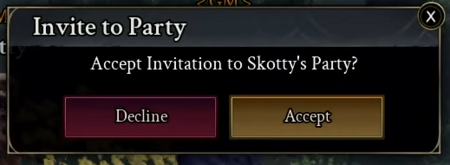Affiliations
An affiliation tree determines how entities are flagged against other entities within its hierarchy.[1][2][3]
- Corrupted players can be attacked (or killed) regardless of other affiliations. This is something that will be tested during Alpha-2.[1]
- Node citizenship.[1][2][3]
- Alliances.[1][2][3]
- Guilds.[1][2][3]
- Parties.[1][2][3]
- Raids.[1][2][3]
- Family.[2]
- Religion.[3]
- Society.[3]
There's node citizenship. There's guild. There's alliance. There's party. There's raid. There's family. All of these types of affiliations have a hierarchy. The highest of which is your node affiliation: So your citizenship is your greatest superceding relationship, which means if you were a part of a guild and the guild has multiple nodes in which its members are citizens of, if there was a war between two of those nodes, the members of those nodes would be first and foremost citizens who defend that node, even against their own guild members.[2] – Steven Sharif
All of these things have some hierarchy; and within that hierarchy there's the ability to participate within certain systems. So for example, if you have a node that has fallen under your vassal state and you're a citizen of the parent node, then you could participate in a siege against the vassal node but if you're a citizen of the vassal node you could not participate as an attacker against the parent node; so there's a hierarchy, unless you were to renounce your citizenship.[3] – Steven Sharif
Group dynamics
Group dynamics aim to bring players together.[5]
- One of the main philosophical pillars behind our design was that PvE must be impactful and inclusive. We want solo players, small groups and large groups to all have a home within our system.[6]
- Ashes of Creation is in development. These systems could change through playtesting and player feedback.[5]
Group sizes

We're not creating a solo game, but it doesn't mean that we don't offer gameplay that is solo centric as well: It lives in addition to the social aspect of What MMOs provide; and so part of what we do in order to to give that element of gameplay is we have quest lines that are devoted towards solo players. We have hunting grounds. Obviously one of the benefits of being a solo player is you get to keep everything that drops. You don't have to share loot with a party or with friends; that's one benefit of being a solo player. But it's going to be more difficult to overcome challenges; and those individuals who are up to taking that additional level of of difficulty are going to excel perhaps in their character progression a bit faster than those who are more group-centric. It's going to be a little bit of a roll of the dice there because there are loot tables, there are reward tables that accompany that, but it's important to note that from a content perspective Ashes of Creation is looking to fulfill both that solo-oriented mind in gameplay as well as the group and social experience; and a lot of times those paths diverge: They move apart, they come back together; and that process is going to be seen throughout the leveling in Ashes of Creation where you'll have more opportunities for solo gameplay and some opportunities for group gameplay.[8] – Steven Sharif
Ashes of Creation is designed for solo players as well as large and small groups.[8][9][10]
- The idea behind an 8-person group is to allow us to really amplify party roles, and to create a need for each of the archetypes in every party.[5]
- Raids will have 40 man groups.[11]
- Content will be tailored for 40, 16 and 8 person group sizes.[12]
- Arenas will have 1 man, 3 man, 5 man and possibly 20 man Free-For-All (Deathmatch) group sizes.[13]
- Castle sieges are expected to have at minimum 250x250 players to be on a single battlefield, with the possibility of increasing this to 500x500 over time.[15][16][17][18]
- The minimum goal is 500 players on a single battlefield. I think we will be able to hit 500vs500 but we shall see.[18] – Steven Sharif
Intuitive grouping
There are systems such as quests, events and monster coins that lend themselves toward intuitive grouping, but no specific decision has been made to include this functionality.[19]
See also
References
- ↑ 1.0 1.1 1.2 1.3 1.4 1.5 1.6 Livestream, July 29, 2022 (1:07:20).
- ↑ 2.0 2.1 2.2 2.3 2.4 2.5 2.6 2.7 Livestream, March 29, 2019 (17:10).
- ↑ 3.0 3.1 3.2 3.3 3.4 3.5 3.6 3.7 3.8 Interview, May 11, 2018 (58:07).
- ↑ Video, February 29, 2024 (19:35).
- ↑ 5.0 5.1 5.2 5.3 Group dynamics blog.
- ↑ About Ashes of Creation.
- ↑ Video, February 29, 2024 (33:57).
- ↑ 8.0 8.1 Livestream, September 30, 2022 (2:40).
- ↑ Livestream, November 30, 2020 (1:20:25).
- ↑

- ↑ Livestream, May 9, 2017 (34:38).
- ↑ February 8, 2019 - Questions and Answers.
- ↑

- ↑ Livestream, May 26, 2017 (48:12).
- ↑ Livestream, September 24, 2021 (52:48).
- ↑ Interview, July 8, 2021 (57:19).
- ↑ Interview, July 19, 2020 (44:28).
- ↑ 18.0 18.1

- ↑ Livestream, May 15, 2017 (29:30).
